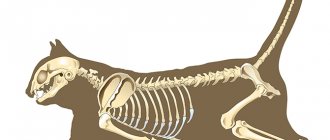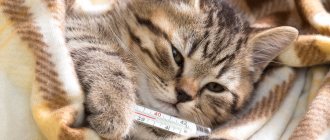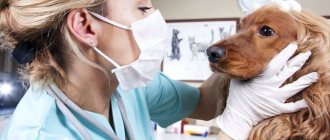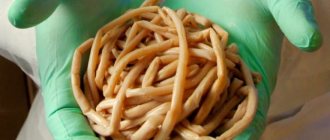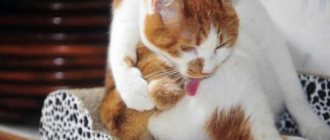Causes
Disease on a pet's tail can occur for various reasons. Often these are: long-standing injuries, severe bruises, wounds, fractures or any other damage. Sometimes, but there are still diseases that are quite difficult to determine. These include: tumors, unknown neoplasms, eczema, osteomyelitis. Any of them requires high-quality qualified treatment in compliance with all requirements and recommendations of a veterinarian. Every loving owner should know why such diseases occur and how to deal with them.
© shutterstock
Treatment method for ringworm
So, earlier we got acquainted with the symptomatic signs of the main types of lichen. But how, in fact, does the healing process itself take place? Treatment of lichen in cats can be carried out using both traditional and medical technology. As a rule, regardless of the choice of one approach or another, the process of combating a disease requires great effort . So, quite often it takes weeks and even months to completely eradicate the disease. In this regard, some experts propose an alternative way to eliminate the threat - euthanasia. Of course, such an option is considered from a serious point of view extremely rarely. As a rule, only young families resort to it, trying to protect a small child from fungal pathogens. In all other cases, standard drug therapy is used, which involves the use of external and internal agents.
The medical approach shows the greatest effectiveness in the treatment of lichen in cats. The doctor conducting the diagnostic study draws up a wellness plan based on the current picture. The way to fight in this case depends on the severity of the disease. So, we can highlight:
- mild form of lichen - potent vaccine preparations (Vakderm-F, Microderm), as well as ointments and solutions for local use (Fungin, Sanoderm, Epacid-F) are used to eradicate the disease;
- severe form of lichen - the treatment process lasts several months, during which vaccines, oral medications (Itraconazole, Gricin) and emulsion products for bathing the pet (Nizoral, Imaverol, Ketoconazole) are used.
Proponents of the traditional approach to treatment also highlight a number of effective methods of combating fungal pathogens. Among them, the most popular methods are:
- bathing and treating the affected areas with a sulfur solution (1 spoon of lime sulphide per 3 liters of water);
- soaking and removing scaly growths with a soap solution (20 grams of laundry soap per liter of water);
- rubbing ointment from wood ash (the product is made using butter in equal proportions);
- cauterization of foci of infection with iodine solution (individual allergic reactions and intolerances are allowed).
Thus, the process of combating a dermatological disease can be built on the basis of folk or medical principles. The traditional approach to treatment usually requires less investment. However, its effectiveness often leaves much to be desired. The medical approach presupposes the need to attract large financial sums. Fortunately, it also provides the fastest and most reliable results. Finally, it is worth saying a few words about preventive measures aimed largely at reducing the risk of infection for pet owners. So, the infected animal is placed in a separate room or enclosure. All items previously in the cat's possession are carefully processed or destroyed. The surfaces of walls, floors and furniture indoors are disinfected daily. For disinfection and wet cleaning, specialized liquids are used (Laina, Akmadez, Duacid). By carefully following these instructions, the pet owner will significantly speed up the healing process and eliminate the possibility of re-infection.
Common diseases
Vertebral caries. The main cause of the disease is a lack of calcium, which occurs as a result of impaired metabolism. If you feel a cat's tail, you can feel formations on it; they resemble beads strung on a thread. If left untreated, the tail will completely lose its mobility, stop bending, and the pet will feel discomfort all the time.
Osteomyelitis is a disease that is caused by inflammatory processes in the bone marrow of the tail. This leads to serious injuries and infectious diseases. The most important symptoms are: lameness of the cat, pain when pressing the tail, lack of appetite. Sometimes, the presence of purulent ulcers may indicate that a sore has appeared.
Photo of a cat with scabs on its back
Separately, I would like to remind you that vaccination against lichen is ineffective, so you should not torment your pet with unnecessary vaccinations.
Tail hair loss
The following symptoms symbolize this problem::
- the presence of bald spots;
- on the upper part of the tail, at its base, the hair has become greasy, greasy and constantly rolls down;
- Under the fur you can find a discharge that is oily and brown in color.
The cause of tail baldness may be a disruption in the functioning and functionality of the glands that produce fat. If fat production is disrupted, then the above changes occur, the skin balance is disrupted and the pet suffers.
Preventive methods
If the kitten's skin is covered with sores and the affected area is gradually expanding, you need to make an appointment with a veterinarian as soon as possible and undergo a comprehensive examination, since the causes of the rash can be varied - from scabs to endocrine disorders.
As a preventive measure, you should monitor your pet’s hygiene, get standard vaccinations according to plan, and establish a nutritional and drinking regime. If a cat is prone to allergies, it is important to identify and eliminate the irritating factor, otherwise drug therapy will not bring results. You should not self-medicate. Sometimes the improvised drugs used do bring relief, but not for long, since eliminating the symptoms does not affect the root cause of their occurrence. Only a properly selected comprehensive therapy regimen will help cure your pet from skin problems and prevent complications.
Ulcers
More often, ulcers occur in short-haired four-legged friends. They can appear along the entire length of the tail, often affecting the root, and this can cause necrosis of the tissues and vertebrae of the tail.
An ulcer on the tail requires serious treatment and attention from the owner. If a crust has formed on it, then it must be removed from there and the wound must be cleaned of suppuration. Be sure to treat everything with an antiseptic for cats. Also, it is worth treating it with ointment (Vishnevsky, streptomycin) and applying a bandage.
© shutterstock
In advanced cases, the cat may develop gangrene, blood poisoning and serious consequences.
Neoplasms
Proliferative ulcerated skin lesions in cats, especially solitary lesions, should always raise red flags for neoplasia. Blastomatous ulcers are formed as a result of the breakdown of tumor tissue. Cytological signs of malignancy of neoplasms are: anisocytosis (change in cell size), pleomorphism (change in cell shape), change in the color intensity of the cytoplasm, anisokaryosis (change in the size of the nuclei), change in the size and shape of the nucleoli, change in the value of the nucleus/cytoplasm ratio. The most common examples of tumors leading to the formation of ulcerative skin lesions in cats are basal cell carcinomas (photo 5), squamous cell carcinoma, mastocytomas (photo 9), less commonly ceruminomas and tumors of the sebaceous glands, tumors of mesenchymal origin (fibrosarcomas, angiosarcomas and others). Erosions and ulcers in the abdominal area, accompanied by lumps in and under the skin, are often associated with breast carcinomas (Figure 7).
Itching caused by helminths
Helminths in cats Helminths not only have a pathological effect on the cat’s digestion. Worms cause loss of essential nutrients by absorbing micronutrients from the intestines. As a result of lack of nutrition, the pet's skin becomes dry, dandruff appears, and the cat licks itself much more often and more intensely, trying to get rid of the itching.
Intoxication of the animal's body with waste products and toxins produced by worms provokes an allergic reaction, skin rashes, and itching. Even a tiny kitten can suffer from helminthiasis after acquiring parasites from an adult cat. Therefore, if the kitten is itching, it is necessary to check its feces for the presence of worm eggs. The area around the anus may also itch when helminths crawl out to lay eggs. The cat then behaves characteristically - it “rides” on the carpets with its butt, relieving the itching.
Some species are transmitted through flea bites to humans. The presence of worms in kittens leads to delayed growth and development, and in pregnant cats, worm infestation can cause miscarriage. In the presence of individual individuals in the body, the disease can be asymptomatic. Fleas also transmit helminthiasis to other pets, so all inhabitants of the house need to be treated.
Medicines for helminths
If the itching is caused by worms, then it is necessary to deworm the animal. For this purpose, as prescribed by the veterinarian, the animal is given Prasitel, Pyrantel, Trontsil K, Kanikvantel, Profender, Polyvercan (sugar cubes), Panacur, Febtal, Dirofen, Milbemax, Drontal. But first you should undergo an examination and determine the type of parasite, since broad-spectrum drugs are much more toxic than those that act selectively.
What to do if your cat scratches its neck until it hurts and bleeds
In any case, scratching the skin to the point of wounds should be a reason to take the cat to the veterinarian. Even if the cause is simple, the doctor will be better able to assess the animal’s condition and prescribe the most effective treatment. The range of therapeutic measures will depend entirely on the source of the itching.
Table: method of treatment depending on the type of disease
| Type of disease | Treatment |
| Demodicosis | Long-term (from 6 to 12 months), including a set of measures:
|
| Helminthiasis | Special anthelmintic drugs are used:
|
| Bacterial infection |
|
| Eczema |
|
| Allergy |
|
| Dermatomycoses | Treatment takes on average 1–2 months:
|
Photo gallery: drugs for the treatment of itchy wounds on the neck of cats
It is worth understanding that itching and wounds due to scratching are only a manifestation and consequence of the disorder, so the problem will not disappear until its source is eliminated. Before going to the clinic, the owner should try to alleviate the animal’s condition. Bleeding wounds must be treated with an antiseptic (chlorhexidine, Miramistin, hydrogen peroxide), which will reduce the risk of secondary infection. You cannot carry out any activities with cosmetics - bathing with shampoo, applying creams, coat powders, etc.
It is also recommended to adjust the diet and exclude all those foods that are prohibited for animals (bread, bagels, sweets, sausages - products from the common table), since an unbalanced diet negatively affects the condition of the skin and can aggravate the course of diseases.
A little theory
The wound in this case is a violation of the integrity of the skin layer, affecting the underlying tissue. It can be superficial (essentially a serious scratch) or deep, affecting even the muscle layer and large vessels. In pets, such pathologies are most often the result of traumatic exposure. They occur during fights, attacks by other animals, after collisions with cyclists or cars, and also include surgical injuries that have to be inflicted on the animal during surgery. In short, there are many reasons. But in this case, it is much more important to us what happens to the wound in the future.
Its healing can occur in two types, first described by the luminary of Russian medicine, N. I. Pirogov. He distinguished between healing by primary and secondary intention. With primary intention, wounds heal only after surgery: their edges are smooth, regenerative processes start immediately. Considering that during any operation the rules of asepsis and antiseptics are strictly observed, and therefore the effect of pathogenic and conditionally pathogenic microflora is completely excluded. This happens in several stages:
Granulation. To protect itself from the penetration of microflora and debris into the wound cavity, the body begins to “darn” the wound with granulation. Fibroblasts and endothelial cells participate in the process, and new blood vessels grow from the latter.
Increasing the epidermal layer. Epithelial cells along the edges of the wound channel gradually begin to “slide” onto the upper surface of the granulation, forming a new layer of skin epidermis.
Myofibroblasts also play an important role in the healing process. It is from these cells that muscle fibers subsequently develop. They play the role of a kind of “ties”, literally tightening the edges of the former wound channel.
In principle, wound healing by secondary intention proceeds similarly, but in this case pyogenic microflora interferes with the process: complete granulation of the wound canal will not occur until all dead tissue and microbes are removed from the wound along with pus and other secretions. And it is with this process that difficulties may arise...
